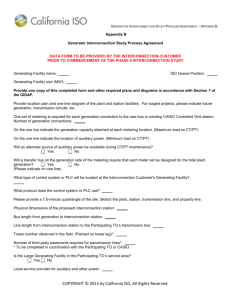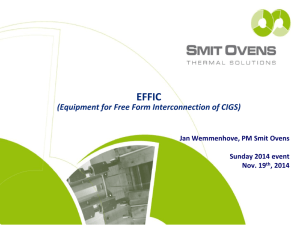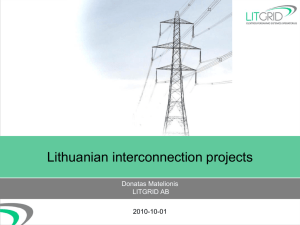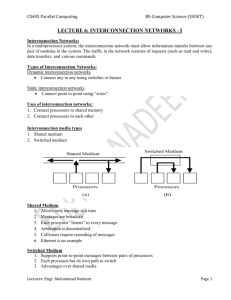service
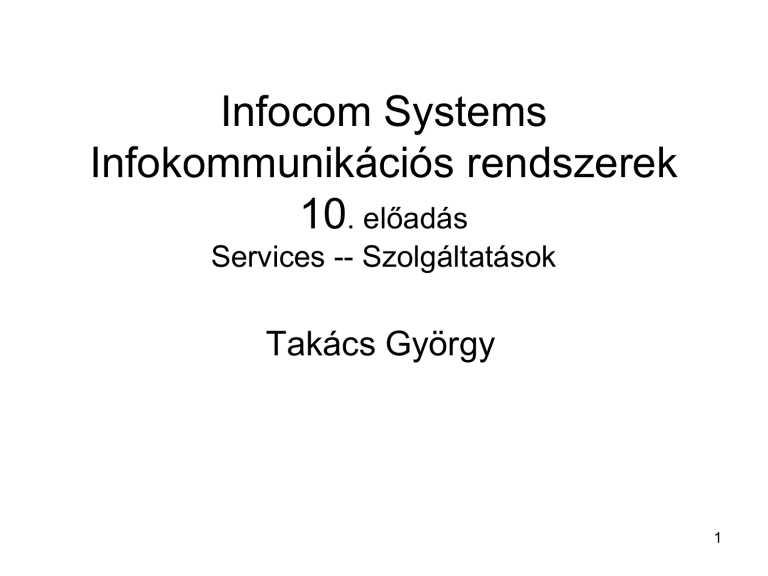
Infocom Systems
Infokommunikációs rendszerek
10
. előadás
Services -Szolgáltatások
Takács György
1
• Előadás helye november 30-án 9.15
134. terem
Lecture in 30th of November (9:15) in room 134.
2
3
Javasolt vizsgaidőpontok
• dec. 16. szerda 10:00
• dec. 16. szerda 13:00
• jan. 6. szerda 10:00
• jan. 6. szerda 13:00
• jan. 13. szerda 10:00
• jan. 13. szerda 13:00
• jan. 27. szerda 10:00
• jan. 27. szerda 13:00
• alkalmanként max. 8 fő
• szóbeli vizsga, angol nyelven
• 408. szoba
4
Alapigazságok az infokommunikációban
• Eddig hálózatokról tanultunk
• Csak szolgáltatást lehet eladni (hálózatot nem)!
• Hálózat nélkül nincs elektronikus kommunikációs szolgáltatás!
• A hálózatépítés és üzemeltetés minden költségét a fogyasztók fizetik meg a szolgáltatás árában!
• Nagyon sokat költünk – önként – elektronikus kommunikációs szolgáltatásokra (többet, mint élelmiszerre és italra)!
• A mérnök-informatikus olyan az elektronikus kommunikációs szolgáltatásokban, mint a nyomdász a könyvszakmában (nem ő írja a regényt, a verset, nem ő rajzolja a képeket….. ). A mérnökinformatikus felel a hatékony, pontos, hiteles információ átvitelért, szolgáltatásért!
5
Basic statements in infocommunication systems
• We have discussed networks
• Only services can be sold (networks are not on the market)
• No networks = no services
• Al the costs of network construction and operation are covered by the users of services.
• Modern people pay big money for electronic communication services (more than for food and drinks!)
• The infocommunication engineers play similar roles in electronic communication like typographers in book publishing. (The text is not written by typographers, the pictures are not painted by typographers…..) The infocommunication engineers are responsible for exact and efficient information transmission and presentation and for such services!
6
7
Value chain in infocommunications
Content
Content and service packaging
Distribution
Presentation/ gateway
End-user devices
8
Shift in the value chain
Component
Suppliers
Telecom
(Infocom)
Suppliers
Telecom operators
End-users of telecom services
New competitors
(EDS, IBM, etc.)
9
The detailed electronic communication value chain
Content
Content and service packaging
Distribution
Presentation/ gateway
End-user devices
Services and applications
Systems and platforms
Components and subsystems
10
Roles in service provision I.
Electronic communication activity : transmission of messages in the form of electronic signals.
• Messages: speech, voice, music, text, picture, video, data file, multimedia file etc.
• Distance issues????
• Is a simple telephone call within a building an electronic communication activity?
• Is the receiving of the radio signals from a far-far star an electronic communication activity?
• Is the opening the garage door by a radio controller an electronic communication activity?
• Is the leasing of a dark fibre an electronic communication activity?
Electronic communication service : activity for other entity for fees (service, facility, feature).
11
Roles in service provision II.
• Requirements concerning electronic communication activity :
– content fidelity (depending on message type , speech <> data, bandwidth <> bit error rate)
– acceptable delay (depending on message type, isochronous services are sensitive on delay and jitter)
• Requirements concerning electronic communication services :
– services for real demand of users,
– affordable price (Iridium, 3DTV!!),
– high penetration (be attractive for many users),
– user friendly services (easy to use, react quickly),
– continuous availability.
12
13
Roles in service provision III.
• Traditional players in the electronic communication services:
– network operators,
– service providers,
– Operator partners (e.g.. Access providers, collocation providers),
– Wholesale and retail partners,
– End users, subscribers, who pay all the bills for the value chain
• Other players in electronic communication services :
– Content providers,
– Content and service packagers,
– Service and application brokers
14
Roles in service provision
IV.
Electronic communication service categories based on user group:
– public services (available for anyone, based on uniform service conditions, subscriber contracts),
– closed users group services (CUG), CENTREX, virtual private network (VPN)
– Interconnection services and access services (services for other service providers).
ATTENTION!!! The network issues are different!!!
The public network can support CUG and a private network can be part of public cervices....
15
Service structures I.
• Teleservices • Bearer services
16
Service structures II.
• Teleservices
– Defined at user interface
– Providing full communication between users,
– E.g. telephone service, telefax service, emergency calls, SMS services…..
• Bearer services
– Defined at network interface
– Providing signal transmission capabilities between network access points
– E.g. 64 kbit/s unrestricted, structured circuit mode bearer service, packet mode bearer service
17
Service structures III.
• Teleservices from provider point of view:
– Basic services (mandatory service elements with minimal quality requirements e.g. real time, understandable…..)
– Supplementary services (to make basic services even more usable, e.g. call transfer, conference call, automatic call beck on busy, wake up services, least cost routing services, credit card based call……
– Value added services (e.g. bank transaction by phone, televoting, telephone based donation, position based services …..)
18
Service structures IV.
• Teleservices from user point of view:
– Interactive services (telephone, videoconference ...)
– Messaging services (voice mail, e-mail ...)
– Retrieval services (account balance retrieval, time table …)
– Distribution services ( cable TV, personalized news by fax …)
19
Service structures V.
• Teleservices/voice:
– Interactive services (telephone, teleconference (voice) ...)
– Message handling services (voice mail…..)
– Retrieval services ( account balance retrieval, time tables…)
– Distribution services (telephone news…..)
20
Service structures VI.
• Teleservices / data and still pictures:
– Interactive services (interconnection two PC for big distance,
POS transaction)
– Message handling services (telex, EDI, e-mail ...)
– Retrieval services (WEB browse….)
– Distribution services ( teletext … )
21
Service structures VII.
• Teleservices / video:
– interactive services (videoconference, telepresence ...)
– Message handling services (MMS ...)
– Retrieval services (… downloading films….)
– Distribution services ( cable TV … )
22
Cisco TelePresence
23
Cisco TelePresence
24
Service structures VIII.
• Teleservices / multimedia:
– Interactive services (videoconference for medical consultation including EKG, EEG, X-ray transmission, multimedia games...)
– Message handling services (MMS….)
– Retrieval services (… downloading multimedia shows …)
– Distribution services (video on demand, pay per view … )
25
Service structures IX.
• Network and terminal requirements:
Voice, music, video
-- Sensitive on delay (max. 300ms)
– Sensitive on jitter (max 30 ms)
– Sensitive on video/voice synchrony (lip-sync)
– Error tolerant, (bit error rate 10 -3 acceptable!!!)
Games
-- Sensitive on delay (max. 10 ms)
-- sensitive on error
Data, still picture
-- sensitive on error (BER min. 10 -6 , error control
-- delay and jitter tolerant (www=world wide waiting)
26
Interactive services / PSTN-ISDN
• Publicly available telephone service, mandatory features:
– Available for public,
– Originating and receiving national and international calls,
– Access to emergency services,
– Provision of operator assistance,
– Directory enquiry services,
– Directories,
– Public payphones,
– Legal interception,
Features are implemented in switches
– Carrier selection,
– Number portability,
– Itemised billing,
– Calling-line identification.
27
Interactive services / IN
• Intelligent Network (IN concept) for easy service creation and provision
28
Interactive services / IN
• Standardised IN elements (CS1):
– Freephone services (zöldszám),
– Shared cost services (kékszám),
– Premium rate services (emelt díjas),
– Virtual card (hívókártya),
– Prepaid card (előre fizetett hívókártya),
– Virtual private network (virtuális magánhálózat),
– Universal Personal Number (személyi hívószám)
29
Interactive services / GSM supplementary services I.
• Calling Line Identification Presentation
(CLIP)
• Calling Line Identification Restriction
(CLIR)
• Connected Line Identification
Presentation (COLP)
• Connected Line Identification Restriction
(COLR)
• Call Forwarding Unconditional (CFU)
• Call Forwarding on Mobile Subscriber
Busy (CFB)
• Call Forwarding on No Reply (CFNRy)
• Call Forwarding on Mobile Subscriber Not
Reachable (CFNRc)
30
Interactive services / GSM supplementary services II.
• Call Deflection (CD)
• Call Hold (HOLD)
• Call Waiting (CW)
• Barring of All Outgoing Calls (BAOC)
• Barring of Outgoing International Calls
(BOIC)
• Barring of All Incoming Calls (BAIC)
• Barring of Incoming Calls when Roaming
Outside the Home PLMN Country
(BIC-Roam)
• Closed User Group (CUG)
• Advice of Charge (AOC)
• User-to-user signalling (UUS)
• Multi Party Service (MPTY)
31
Interactive services / IP telephony
• IP telephony: services or technology?
technology technológia
32
Defining VoIP
ITU Internet Report 2001
• IP Telephony – carriage of voice over IPbased networks irrespective of ownership
• Voice over Internet Protocol (VoIP) – voice traffic carried wholly or partly using
IP over broadband networks competing with incumbent operators
33
Interactive services / IP telephony
34
35
QoS
QoS (Quality of Service) is a major issue in VOIP implementations. The issue is how to guarantee that packet traffic for a voice or other media connection will not be delayed or dropped due interference from other lower priority traffic.
Things to consider are
Latency : Delay for packet delivery
Jitter : Variations in delay of packet delivery
Packet loss : Too much traffic in the network causes the network to drop packets
Burstiness of Loss and Jitter : Loss and Discards (due to jitter) tend to occur in bursts
36
37
What is the future?
• Traditional Telco's, traditional services and traditional business model with precise billing?
• New operators, new business model and free-like services (like Skype)?
38
39
40
Using dialog based services for other purposes
• Telefax
• Voice mail
• SMS
• Internet access by telephone modems
• WAP
• Call center
• Teleconferences
• Televoting
• Donation by calls
• Buying, parking by mobile phones…
41
42
43
Wireless
Operator
Infrastructure
Vendor
BT Undisclosed
(U.K.)
Lucent eAaccess
LTD
(Japan)
France
Telecom
Siemens
Global IMS Deployments
Service Planned
BT Fusion (formerly Project Bluephone) fixed/mobile converged phone service
Multimedia, HSDPA
Fixed-mobile convergence
MMO2
(U.K.)
Saunalahti
(Finland)
Siemens
Nokia
Sprint
(U.S.)
Lucent
Telecom
Italia Mobile
Ericsson and Nokia
Launch Date
September 2006, Announced June
2006 With 400 Early Adopters
Announced February 2005
Push-to-talk over cellular (POC), multimedia conferencing
VoIP and rich multimedia to both mobile and fixed telephony customers
EV-DO
Video sharing
First two phases of three-phase project complete; phase three includes ~ 200 customer trial.
EOY 2005 first launch in two-year program
Announced in June 2005, launch date not yet set
Announced in December 2004; deployment of IMS solution starts in
2005
Mass market launch 2Q05
Telefonica
(Spain)
Ericsson
Telia Sonera Ericsson, Nokia and
Siemens
Telkomsel
(Indonesia)
Nokia
Converged wireless/wireline IMS deployment
Instant messaging, video sharing, gaming among different mobile operators
3G services, such as video sharing. Based on standardized 3GPP and IETF technologies.
Enabled by IMS core network
Announced in April 2005, deployment of IMS solution starts in late spring
2005
Trial in spring 2005
Six-month trial under way now
TMN
(Portugal)
Nokia Video sharing Service launched in June 2005
44
IMS Elements
45
IMS Layered Architecture
46
http://en.wikipedia.org/wiki/IP_Multimedia_Subsystem#3GPP_Specs
47
Network services
• Leased line services
• Interconnection services
• VPN - Virtual Privet Network Services
• Network Access Services
• Billing services
• Centrex services
48
Leased line services
• Transparent transmission capacity without switching function
• For operator partners to extend their networks,
• For interconnection of network nodes
• For end users to access networks or services
• Interconnection of private network nodes
• Main characteristics: service features, transmission parameters, interface types,
• Main classes: analogue/digital, two wire/four wire, simple / observed / managed
49
Standardised leased line services
• Ordinary Quality Voice bandwidth (2 wire) ETS 300448
• Ordinary Quality Voice bandwidth (4 wire) ETS 300448
• 64 kbit/s ETS 300 288, ETS 300 289
• 2048 kbit/s E1 ETS 300 418, ETS 300 247
• Nx155520 kbit/s STM-1 ETS 300 299
50
Interconnection services
• Call origination, call termination, call transit as the tipical traffic situation
• Support services (e.g. billing)
• Carrier selection services
• Standard solutions for interconnection PSTN, ISDN and
GSM ETS 300 356
• Peer-to-peer interconnection without detailed traffic accounting
51
Interconnection services
• Mandatory for public networks!
• Technical, commercial and legal aspects!
• Critical issues: which services are supported, where is the interconnection point?
• Network operators with significant market power have special obligations!
• Reference interconnection offers are accepted by
Authority.
• All the accepted interconnection reference offers in
Hungary are bringing to justice.
52
Functions of interconnection
53
Functions of interconnection
54
Functions of interconnection
55
Functions of interconnection
56
Functions of interconnection
57
Functions of interconnection
58
Functions of interconnection
59
Services to gain content
• „Telefonhírmondó” 1881, Puskás Tivadar
• In Budapest from 1882 14,5 hours daily for thousands of subscribers during 30 years period
• Radio broadcasting killed it.
• What is the future of radio broadcasting? No frequency band, no CD quality?
60
EU content policy
61
EU content policy
62
Creative content
• Copyright is the basis for creativity. It is one of the cornerstones of Europe's cultural heritage, and of a culturally diverse and economically vibrant creative content sector. In Europe, the cultural and creative sectors (from published content such as books , newspapers and magazines via musical works and sound recordings , to films , video on demand and video games ) generates a turnover of more than €
650 billion annually, contributes to 2.6% of the EU's GDP and employs more than 3% of the EU work force.3
European Policymakers therefore have the responsibility to protect copyright, including in an evolving economic and technological environment.
63
• Digital technologies bring a number of changes to the way creative content is created, exploited and distributed. New content is being created by traditional players such as authors, producers, publishers ; but user-created content is playing a new and important role, alongside professionally produced content .
64
Stakeholders
• Internal stakeholders:
– owners – return of investment
– managers – profitable operations
– employees – maximum salary
• Outsider stakeholders:
– users, subscribers, buyers – maximal services and minimum prices
– competitors – increase market share
– suppliers – maximal sale
– state and local authorities – regulation of the market
65
Music
• Stakeholder consultations reveal that the online dissemination of music , with its multiple causes the biggest challenges with respect to online licensing. Within the music industry, different rightholders own different rights.
• Rights of authors are administered by authors’ societies on behalf of the authors and music publishers. Authors hold the rights in the composition of the lyrics/music, which include the following:
• – Right of reproduction i.e. the right to reproduce the work by making physical (e.g. CD) or intangible (e.g. upload, download) copies.;
• – Right to communicate the work to the public.
• Rights of performers, and record producers (record labels) are related rights of producers and performing artists which allow them to control or obtain remuneration for the use of a sound recording.
66
Publishing
• The online distribution of in-print books is a more straightforward matter, as the publisher or the author owns the right to make the book available online. More complex issues arise with respect to the mass digitisation of out-of-print books or orphan books ( the owner of the "digital" rights is unknown).
• Online distribution of literary works and e-books is still a nascent market. Commercial projects are being developed outside Europe, without necessarily complying with EU copyright rules. From a European perspective, the rights of authors and publishers should be duly protected and secured when their works are digitised and made available through online services.
• Digitisation of books and other literary and artistic works under the Europeana project is a significant development.
However, there is also a risk that a considerable proportion of the books in Europe's national libraries cannot be incorporated into mass-scale digitisation and heritage preservation efforts such as Europeana or similar projects for rights clearance reasons, since their rightholders cannot be identified (orphan works) or must expressly consent (out-of-print works).
67
Audiovisual (Film, Video-on-Demand)
• There are many more rightholders involved in the creation of a film: director, producer, actors, screenplay and music soundtrack authors , to mention but a few. In addition, the rights of performers (actors) are not fully harmonised at
European level, so that actors enjoy different rights in different Member States.
• The film producer usually benefits from a transfer of rights from the creators involved in the film.
• The new video-on-demand (VOD) services
• involves several challenges. Statutory and contractual provisions relating to release windows for VOD can act as a barrier to the availability of content on digital platforms across borders, because of the time lapse between VOD and other releases.
68
Video games
• The video games industry was born digital and relies to a large extent upon online interactivity.
This is why it remains one of the most consistent online audiovisual markets, and less subject to cultural and linguistic differences. Thus many consumers across Europe can enjoy video games regardless of their language and country .
69
The content
• The free flow of information and access to information are fundamental rights of human. The
European Convention of Human Right authorise national bodies to limit the harmful and dangerous content.
• Representation of violence in media
– Free access (unencrypted)
– Fee-paying (encrypted)
– Programming time
70
Who is responsible for the content?
• As the several hundred years practice in Europe clearly the editor in chief.
• Which body is competent in debates concerning content?
• In the actual media law The NMHH (Nemzeti Média
és Hírközlési hatóság). President is nominated by the prime minister for 9 years!
• What is the responsibility of electronic communication service providers?
71
Protection of children and the dignity of human being
• Illegal contents: child pornography, violent pornography, extreme violence, incitement to racial…..
• Limited contents: legally publicised to adults but might be harmful for children….
• Protection methods:
• Markup with cooperation the content providers,
• Classification of programs
• Anti violence „V” chip (Canada)
• Limited content only between 23.00 pm – 5.00 am as in the Hungarian media law
72

